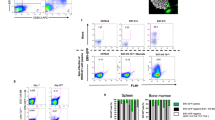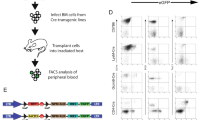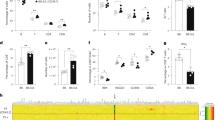Abstract
CERTAIN retroviruses (RNA tumour viruses) have been implicated in the autoimmune disease of New Zealand mice1. These mice produce large numbers of xenotropic retroviruses2,3 and contain high concentrations of the retroviral envelope antigen gp 69/71 in their serum and tissues4. Moreover, gp 69/71 and the corresponding antibodies contribute to the immune deposits in the nephritic kidneys of NZB and (NZB × NZW)F1 mice4. Nevertheless, it is not established that xenotropic viruses are the primary cause of the autoimmune disease of NZB mice. Conceivably, these agents may be involved only secondarily. The presence of RNA viruses in NZB mice may explain neither the production of antibodies against DNA, nucleoproteins, and erythrocyte antigens nor the anomalies of T- and B-lymphocyte function5. Transmission of autoimmunity has not been achieved with cell-free filtrates from NZB mice6, nor by transplanting NZB lymphomas7 which are known to produce large numbers of virus particles8. Only spleen cells from old NZB mice can transmit the autoimmune disorder6. Transmission of the disease with cell-free extracts is unlikely to succeed because the NZB xenotropic virus cannot productively infect mouse cells; it can infect only cells of heterologous species2,3. Here we deal with the vertical transmission of NZB viral genes as Mendelian traits—a phenomenon that has been demonstrated with other retroviruses9—to test the hypothesis that the development of autoimmunity in NZB mice and their crosses is independent of the expression of high titres of xenotropic viruses. We have found that the high grade expression of infectious xenotropic virus characteristic of NZB mice is a genetically determined trait. Two independently segregating loci seem to specify the NZB phenotype. So far, animals that are virologically like NZB have failed to develop signs of autoimmune disease.
This is a preview of subscription content, access via your institution
Access options
Subscribe to this journal
Receive 51 print issues and online access
$199.00 per year
only $3.90 per issue
Buy this article
- Purchase on Springer Link
- Instant access to full article PDF
Prices may be subject to local taxes which are calculated during checkout
Similar content being viewed by others

References
Mellors, R. C., Shirai, T., Aoki, T., Huebner, R. J., and Krawczynski, K., J. exp. Med., 133, 113–132 (1971).
Levy, J. A., Science, 182, 1151–1153 (1973).
Levy, J. A., Kazan, P., Varnier, O., and Kleiman, H., J. Virol., 16, 844–853 (1975).
Yoshiki, T., Mellors, R. C., Strand, M., and August, J. T., J. exp. Med., 140, 1011–1027 (1974).
Talal, N., Progr. clin. Immun., 2, 101–120 (1974).
Burnet, F. M., Progress in Immunology, 5 (edit. by Brent, L., and Holborow, J.), 27–36 (North-Holland, Amsterdam, 1974).
East, J., Prog. exp. Tumor Res., 13, 84–134 (1970).
Mellors, R. C., and Huang, C. Y., J. exp. Med., 124, 1031–1038 (1966).
Rowe, W. P., J. exp. Med., 136, 1272–1285 (1972).
Melief, C. J. M., et al., Proc. Soc. exp. Biol. Med., 149, 1015–1018 (1975).
Fischinger, P. J., Blevins, C. S., and Nomura, S., J. Virol., 14, 177–179 (1974).
Callahan, R., Lieber, M. M., and Todaro, G. J., J. Virol., 15, 1378–1384 (1975).
Stephenson, J. R., Reynolds, R. K., Tronick, S. R., and Aaronson, S. A., Virology, 67, 404–414 (1975).
Ghaffar, A., and Playfair, J. H. L., Clin. exp. Immun., 8, 479–490 (1971).
Long, G., Holmes, M. C., and Burnet, F. M., Aust. J. exp. Biol. Med. Sci., 41, 315–322 (1963).
Lewis, R. M., Stollar, B. D., and Goldberg, E. B., J. Immun. Meth., 3, 365–374 (1973).
Tonietti, G., Oldstone, M. B. A., and Dixon, F. J., J. exp. Med., 132, 89–109 (1970).
Author information
Authors and Affiliations
Rights and permissions
About this article
Cite this article
DATTA, S., SCHWARTZ, R. Genetics of expression of xenotropic virus and autoimmunity in NZB mice. Nature 263, 412–415 (1976). https://doi.org/10.1038/263412b0
Received:
Accepted:
Issue Date:
DOI: https://doi.org/10.1038/263412b0
This article is cited by
-
T-helper cell intrinsic defects in lupus that break peripheral tolerance to nuclear autoantigens
Journal of Molecular Medicine (2005)
-
Systemic lupus: basic mechanisms and prospects for specific immunotherapy
Japanese Journal of Rheumatology (1997)
-
Mechanisms of the pathogenic autoimmune response in lupus: Prospects for specific immunotherapy
Immunologic Research (1995)
-
Differential gene expression in autoimmune mice
Survey of Immunologic Research (1985)
Comments
By submitting a comment you agree to abide by our Terms and Community Guidelines. If you find something abusive or that does not comply with our terms or guidelines please flag it as inappropriate.


